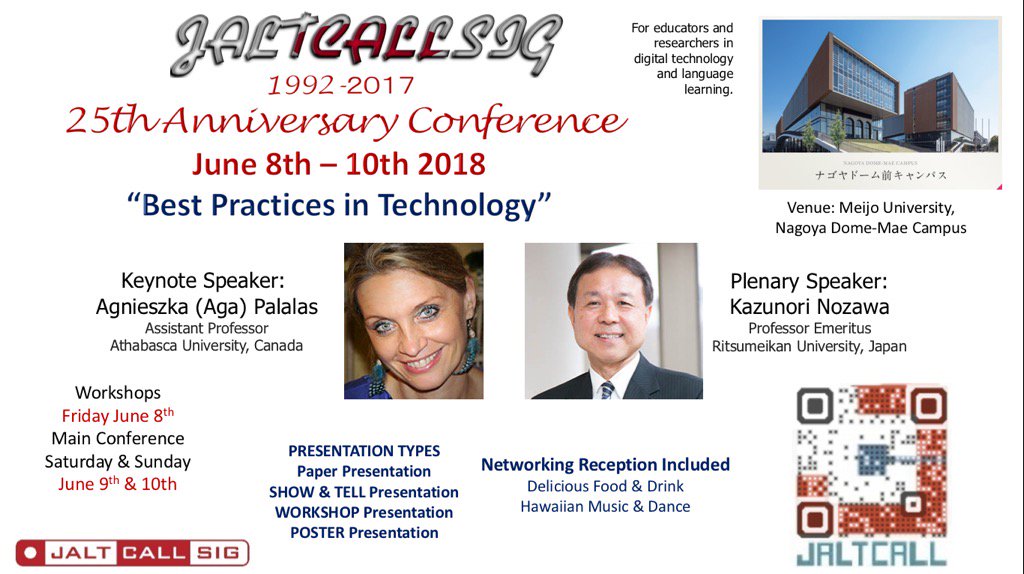Bring Your Own Device (BYOD) policy or recommendation PRESENTATION June 2018
Japan Association of Language Teachers Computer Assisted Language Learning
Special Interest Group 25th Anniversary Conference 2018
Presentation: Saturday 2:10 pm - 2:40 pm Room 403
Anthony Brian Gallagher
MAODE(Open), PGCODE(Open), ProGCE, B.Sc.(Hons.)
Member of the General Teaching Council of Scotland
Institution: Meijo University, Faculty of Foreign Studies
Bring Your Own Device (BYOD)
policy or recommendation?
What is the impact on students of a BYOD recommendation rather than a policy?
Device lending data trends are analyzed to establish the differences in student needs and wants between iPad tablet devices and standard PC laptops.
Abstract
What is the impact on students of a BYOD recommendation rather than a policy? The device lending data trends are analyzed to establish the differences in student needs and wants between iPad tablet devices and standard PC laptops. What correlations may exist between lending data and accessibility? Will device lending capacity have an impact on future borrowers and the entire university recommendation (not policy)? This presentation will show borrowing data of devices and student preferences along with a student questionnaire to establish if there are any correlations between the types of devices, access to those devices and the limitations of the Japanese university involved. I suggest that no policy is pushed on students because of the pre-knowledge that it is fundamentally flawed. Trends in the data will clearly show that students have a preference for one specific device over the other because of the limitations of the latter. Money spent on tablet devices would be better spent on PC devices that are more practical and effective for students to function within their university environment. This presentation confirms with data the need for ensuring the user experience is best prepared for and to show how finances should be spent for maximum effectiveness for institutions.
What correlations may exist between lending data and accessibility for these 2 types of devices?
| Learning Commons Lending Service Data 2016 | ||||||||||
| April | May | June | July | August | September | October | November | December | January | |
| Laptop PC | 83 | 104 | 222 | 279 | 83 | 268 | 239 | 329 | 182 | |
| iPad | 55 | 43 | 66 | 62 | 13 | 28 | 31 | 21 | 13 | |
| Others | 4 | 13 | 7 | 6 | 0 | 2 | 23 | 26 | 2 | |
| Total | 142 | 160 | 295 | 347 | 96 | 298 | 293 | 376 | 197 | |
| Students | 138 | |||||||||
| Learning Commons Lending Service Data 2017 | ||||||||||
| April | May | June | July | August | September | October | November | December | January | |
| Laptop PC | 907 | 871 | 1306 | 1381 | 166 | 1364 | 1121 | 1513 | 680 | |
| iPad | 25 | 8 | 21 | 17 | 3 | 17 | 7 | 23 | 12 | |
| Others | 43 | 42 | 37 | 36 | 23 | 67 | 28 | 59 | 20 | |
| Total | 975 | 921 | 1364 | 1434 | 192 | 1448 | 1156 | 1595 | 712 | |
| Students | 2101 | |||||||||
| April | May | June | July | August | September | October | November | December | January | |
| 2016 | 58% | 65% | 75% | 80% | 86% | 90% | 82% | 88% | 92% | |
| 2017 | 93% | 95% | 96% | 96% | 86% | 94% | 97% | 95% | 96% | |
Conclusion
I suggest that no policy is pushed on students because of the pre-knowledge that it is fundamentally flawed.
üJapanese universities have no affiliation with companies to promote any one device.
üMany Japanese universities have little or no technical support for students.
üJapanese universities should adopt a leasing agreement with a manufacturer.
Trends in the data show that students have a preference for one specific device over the other because of the limitations of the latter.
Money spent on tablet devices would be better spent on PC devices that are more practical and effective for students to function within their university environment.
This data confirms the need for ensuring the user experience is best prepared for and to show that finances should be spent for maximum effectiveness for institutions.
Future work
Does device lending capacity have an impact on future borrowers and the entire university recommendation to become a set policy)?
1.Administrations should pay attention to internal data to furnish students with the correct information and advice on information technology.
2.There is a need for extended ICT support
3.Students need ICT training to enrich their user experience and to increase their output potential.
For more information on the User Experience please read some of my other publications and presentations.
Considering the user experience
Related Work:
üGallagher, A.B. (2018) Cosmetic & Disruptive Technologies Management in Education
üGallagher, A.B. (2017) Assistive & Disruptive Technology in Learning
üGallagher, A.B. (2017) Assistive, Disruptive and Cosmetic Technology in Education
üGallagher, A.B. (2016) Killing Them Softly with Phone Love
üGallagher, A.B. (2015) Reducing the Dangers of Computer Vision Syndrome while promoting Learner Autonomy.
üGallagher, A.B. (2014) Using a Virtual Learning Environment to Teach Referencing and Researching, Polls and Plenaries, Collaboration and Success.
THE FAILINGS OF A BYOD RECOMMENDATION





Comments
Post a Comment